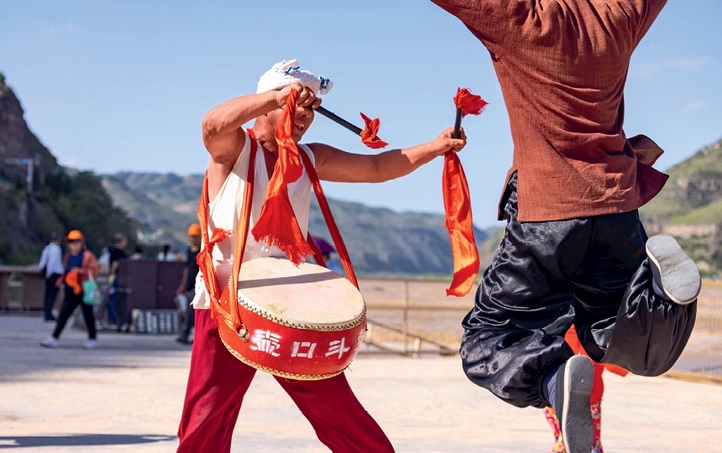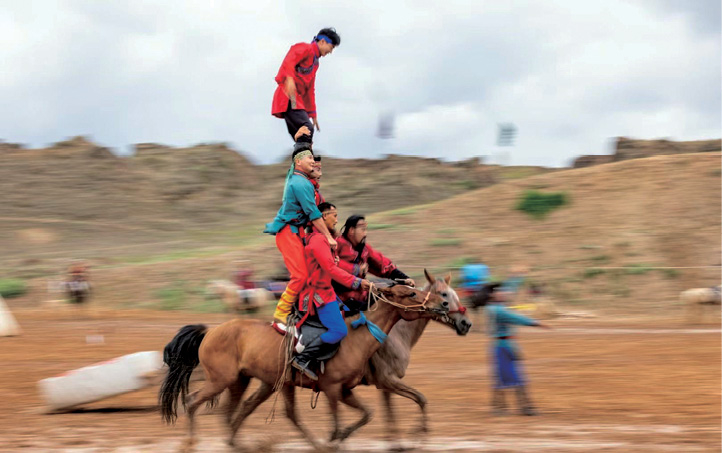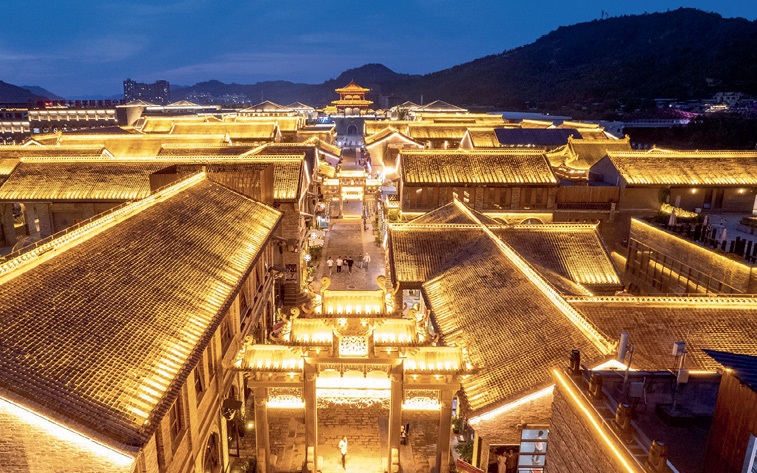
As Dan Sandoval goes from place to place in China, his camera has always been his best companion. Photos courtesy of Dan Sandoval
“This is the Great Wall. It’s gorgeous. That’s what hikers dream of. Layers upon layers of mountains, the remains of the ancient Great Wall, the cities in the back, the colors, the sky. That’s China in a nutshell.”
That was a Beijing-based American photographer Dan Sandoval’s tribute while standing in the Guidegou section of the Great Wall, watching the sunrise with his companion, British adventurer Ash Dykes.
In the autumn of 2019, at the invitation of Dykes who was filming one episode of the six-part TV series The Great Wall with Ash Dykes in northwest China’s Gansu Province, Dan set out to climb the Guidegou section in the early hours of the day in the wilderness of the northern Helan Mountains in Shizuishan City, Gansu Province. It was freezing at minus 6 degrees Celsius and still dark. After a 90-minute trek, they climbed to an altitude of 1,900 meters. Sandoval said he had always wanted to shoot the “wild parts” of the Great Wall, which are very different from the famous sections in Beijing.

The Ansai waist drum dance, a folk dance performed with vigorous movements.
The Guidegou section was built in 1488 during the reign of Emperor Hongzhi of the Ming Dynasty. It was built by farmers and soldiers using stones and mud and took more than 20 years.
“Though out of breath, we marveled at the stunning scenery of Shizuishan and its surrounding valleys,” Sandoval said, describing the shooting experience as “definitely worthwhile.” In his eyes, although the Great Wall has different beauty at different times of the day, its appearance in the wilderness of China’s vast northwest in the morning is breathtaking in a unique way.
Sandoval, who comes from Los Angeles, has traveled and filmed in over 50 countries across seven continents and now lives in China. “In 2008, tired of my studio work in the U.S., I came to China, thinking I would be here one or two years, but it has turned out to be 16 years!” he said. He hopes his photographs will inspire others to embark on adventures as well.

Mongolian performers’ trick riding in the Shuidonggou Horse Riding Show in Yinchuan, northwest China's Ningxia Hui Autonomous Region on August 3, 2023.
Seeing Chengdu Change
Sandoval, a professional photographer, learned commercial photography at what was then the Brooks Institute of Photography. After graduation, he first worked in the U.S. for several years. Then with the hope of trying something different for himself, he went to Chengdu in southwest China to live in October 2008 and has traveled throughout the country since then.
He lived in Chengdu for the first six years, then in Beijing for the next six, and now mainly travels between Beijing and Shanghai for work.
“When I first arrived in Chengdu in 2008 to live, I didn’t speak any Chinese except for three phrases ‘Nihao’ (hello), ‘Duo shao qian’ (how much does it cost) and ‘Tai gui le’ (too expensive),” he said. “Before that, in the fall of 2006, I had been here for a short visit for my university program. Two years later, when I landed here again to live, oh, this was very different from 2006 when Chengdu had a lot of farmland outside the Third Ring Road. In October 2008, I wasn’t sure I was in the same city. Chengdu had changed a lot in just two years. It was more developed with more progress. Big buildings, a subway line, and modern facilities came up one by one.”
In the beginning, he did editorial work for magazines both in and outside Sichuan, such as Vogue. Then he worked with the Sichuan tourism department to produce travel brochures, and also on ad campaigns for destinations for corporate companies.
To him, Chengdu is the capital of leisure and a laid-back lifestyle. He was delighted to see that residents, dressed stylishly or comfortably, strolled in the streets “as slowly as snails.” With his camera, he recorded them and their lives, listening to the sound of mahjong tiles being shuffled and music from traditional stringed instruments.
“In Chengdu, women are in charge of the house. That’s the so-called Pa’erduo (literally meaning “lead people by the ear” in Sichuan dialect) tradition, something very interesting. Chengdu residents have a carefree but persevering attitude in their genes. That’s why no matter how international or modern Chengdu becomes, their style remains and people safeguard the essence of life in old Chengdu,” Sandoval said. However, he left Chengdu for Beijing because the capital had more job opportunities and a drier weather.
In the summer of 2023, when the FISU World University Games were held in Chengdu, Sandoval was invited together with other professional photographers to cover the event. “Whenever I go to Chengdu, it feels like returning to my old hometown. I really enjoy revisiting it. I wish I had more excuses to go to Chengdu all the time,” he joked.
Almost a “walking encyclopedia” of Chengdu, Sandoval has many useful tips for new visitors in Chengdu. “Xipu Town in northwest Chengdu has the best chuan chuan (spicy skewered meat and vegetables), and Leshan, a city nearby, has the best boboji (skewered meat and vegetables stewed in spicy soup and served in a deep bowl).”

An aerial view of the Jin Yan’an scenic area in northwest China’s Shaanxi Province.
Beijing’s Promise and Challenge
The varied culture and vast, beautiful land has kept him in China much longer than he had planned in the beginning. He remembers a wide range of adventures like exploring a local vineyard and local wine in Yinchuan City in Ningxia in 2023, a riding performance by a Mongolian ethnic group in the Shuidonggou Horse Riding Show in the city, and then the totally different experience of visiting the Hainan Free Trade Port in the south. As he goes from place to place, his heavy travel kit is always with him, containing his camera, different lenses, filters, a tripod, and even a drone.
When there’s no work, he stays in Beijing. “Beijing is more comfortable to live in (amenity-wise) but more expensive. Everything has its good and bad sides. You have to balance the cost of living with how much work you’re getting. I enjoy the challenges of living here as much as the beauty of this country” he said.
He thinks he has done a lot in “this beautiful and vast country” with his “travel photos.” “I try to show people the beauty of where I go. I try to inspire them to travel and go to places,” he said. Sandoval used to be an adviser for sustainable tourism in the Jiuzhaigou nature reserve in Sichuan which houses the Dagu Glacier Park. He would give lectures at different places, talking about photography and how to get along with people in different places.
The COVID-19 pandemic affected his business too when it hit lives worldwide. “My business was affected a lot in the last few years,” he said. “I was doing travel photography before COVID, and then turned to more industrial work. But luckily travel work is starting to come back. So I’m hoping to do more international work this year.” 
